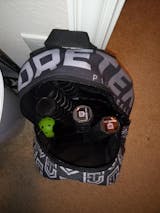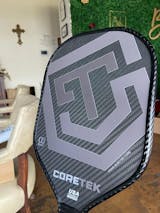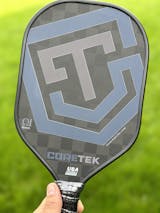The awaited spin and outbound Azimuth component for coefficient of restitution should be coming any day although our company has never received any information about it or in fact any knowledge about it we have found this all open source on the internet and places were stupid people leave it. By taking away ball compression and adding spin as a property of the paddle somehow we will have totally placed all properties of gameplay on the paddle and made it in an infinite whipping boy.
You will not see any different paddles like gearbox in the future they are gone for a reason and they are gone for good probably. Testing the resultant spin of a paddle tells you only about the spin produced in that collision just like coefficient of restitution. It does not tell you anything exclusively about the paddle and anyone who takes their paddles off the market for something like coefficient of restitution is out of their mind or has already settled.
Like pickleball coefficient of restitution spin is just another attempt to attend a property that is both a property of a ball and a paddle exclusively on the paddle. As this test does not consider stiffness even though that is the rationale it can only do one thing which is discriminated against paddle mass. Don't believe me it's provable if you consider stiffness static and you test coefficient of restitution you will only be looking at a result of mass.
Indirect Analysis of Paddle
1. Surface Friction
The spin rate generated is influenced by the friction between the paddle surface and the ball. While not directly measured, the friction coefficient (u) plays a crucial role in spin generation. The relationship can be expressed as:
w = k*u*vi*sin(a)
Where w is the spin rate, k is a constant, vi is the incident velocity, and a is the impact angle.
2. Elasticity
The paddle's elasticity affects the energy transfer during collision. This is implicitly measured through the rebound velocity, though not explicitly analyzed in the procedure. The coefficient of restitution e could be calculated as:
e = vf/vi
Where vf is the final (rebound) velocity and vi is the initial velocity.
3. Stiffness
The paddle's stiffness influences the contact time and energy transfer. While not directly measured, it affects the spin rate. The contact time tc in a simplified model can be related to stiffness k and ball mass m:
tc = pi*sqrt(m/k)
Limitations in Material Property Analysis
-
No Direct Measurement of Surface Properties
The procedure doesn't include any direct measurements of surface roughness, texture, or material composition.
-
Absence of Deformation Analysis
The test doesn't measure or analyze paddle deformation during impact, which could provide insights into material properties like Young's modulus.
-
Lack of Temperature Dependency Studies
While the procedure controls for temperature, it doesn't investigate how paddle properties might change with temperature, which could reveal information about the material's thermal characteristics.
-
No Frequency Analysis
The test doesn't include any frequency analysis of the impact, which could potentially reveal information about the paddle's natural frequencies and internal structure.
Conclusion
While the test procedure is designed to measure spin rate, it does not directly analyze the material properties of the paddle in a comprehensive scientific manner. The test indirectly probes some paddle characteristics through their effect on spin generation, but lacks the specific measurements and analyses required for a thorough material property investigation.
To truly analyze the paddle's material properties, additional tests would be necessary, such as:
- Surface profilometry for roughness measurement
- Stress-strain tests for elasticity and stiffness quantification
- Thermal analysis for temperature-dependent property changes
- Vibration analysis for internal structure characterization
In its current form, the test is more focused on the performance outcome (spin rate) rather than the intrinsic material properties of the paddle. While this may be sufficient for regulatory purposes in the sport, it falls short of a comprehensive scientific analysis of paddle material properties from a physics perspective.









